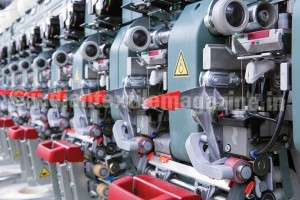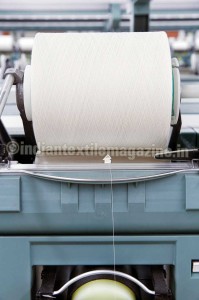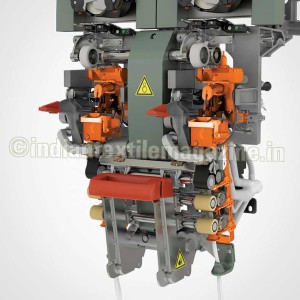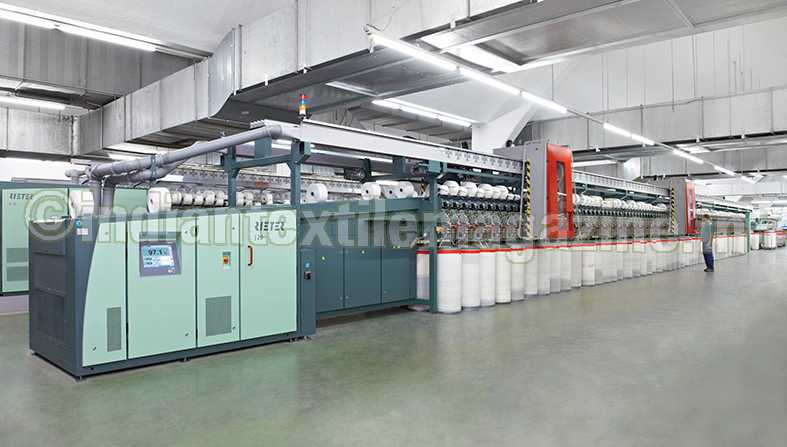The new J 20 is another milestone in the development of Rieter air-jet spinning. With 200 spinning units per machine, the J 20 is twice as long as conventional air-jet spinning machines. The unique machine design and innovative automation make this leap in productivity possible.
The main advantage of the new J 20 is the reduction in piecing cycle time by one-half. This is achieved by means of the new, automated piecing preparation process, which significantly reduces the robots’ workload. The spinning unit itself removes the yarn defect and injects the yarn end through the spinning tip.

The new spinning unit, developed for high winding speeds, produces heavyweight packages in unique quality. The J 20 combines this with a space-saving machine design coupled with high flexibility and very easy operation.
200 spinning units with innovative automation
The significant reduction in piecing cycle time now enables the J 20’s efficient robots to serve up to 200 spinning units (Fig. 1), without any compromise on machine efficiency.
Automated piecing preparation (Fig. 2) makes the piecing process more independent of the robot. In the event of a quality cut – and these account for approximately 85 per cent of all stoppages on an air-jet spinning machine – the spinning process on this spinning unit is interrupted under controlled conditions. A newly-integrated suction and cutting device on each spinning unit draws in the yarn end. The winding unit rotates the package backwards and the yarn defect is fed securely into the new suction device. The yarn defect is cut and the yarn end held in place. As soon as the robot has centered itself on the spinning unit, the new unit injects the yarn end through the spinning tip. The robot takes hold of the end and immediately starts the piecing process.
High productivity

A total of 200 highly productive spinning units per machine, two machine sides which can be adjusted independently of each other, each with 100 spinning units – this is where the J 20 sets new standards. Innovative technology components enable productivity to be increased to 450 m/min in practice. The handle, i.e., characteristics of the yarn, can also be adjusted according to the sphere of application of the yarn. Whether maximum tenacity, minimum hairiness or soft hand are required, the J 20 produces the optimal yarn for the required end use.
Cans with a diameter of 500 mm arranged in two rows under the machine make long production times possible without manual intervention.

The J 20 enables packages 300 mm in diameter and now up to 4.5 kg in weight to be produced, so that higher efficiencies can be achieved in subsequent processes. This has been made possible by the further development of the winding unit (Fig. 3), for which the mill-proven individual drive concept has been retained. Package drive and yarn displacement are new.
The drive motor for the package is now integrated in the winding cylinder, thus saving space. Designed for high winding speeds, the package is now driven consistently and reliably.
Yarn displacement is via a ceramic yarn guide operating linearly. In front of the package the thread guide is mounted on an apron and is moved to the left and right by a high-performance motor. The crossing angle, and thus the speed of the yarn guide, can be entered on the machine panel.
Together with the adjustment of the package contact pressure, cylindrical packages of all kinds can therefore be produced. Yarn displacement is automatically adjusted over package build-up. Higher density means longer yarn lengths or a higher weight per package. The result is a package with optimal take-off behavior in downstream processing.
A convincing machine concept

The J 20 impresses with its clean-lined, space-saving concept appropriate to mill operations. Individual drive technology enables the spinning units on both sides of the machine to be set independently of each other. High-capacity cans are arranged in two rows under the machine, thus saving space. The feed sliver covers a short, direct path to the drafting system. False draft of the sensitive sliver caused by a long distance from the can to the spin unit is eliminated.
Machine operators have an overall view of the cans, the spinning units and the winding heads. They can remedy malfunctions efficiently and replace empty cans rapidly and promptly.
The patented traversing system in the spinning unit (Fig. 4) prolongs the service life of aprons and top roller covers. The sliver funnel, the spinning nozzle housing and the yarn clearer are mounted on the traversing unit. The feed sliver in the drafting system and the finally spun yarn are thus moved continuously over 3-4 mm. Wear is therefore distributed over a larger surface area, and the service life and thus the productive cycles of the machine without maintenance downtimes are considerably prolonged.
Com4 jet yarn, the convincing end product

roller covers.
Com4 jet yarn is the convincing end product of the J 20 air-jet spinning machine. Depending on the sphere of application, the yarn is optimized within a short time by means of machine settings and easy replacement of technology components.
A newly-developed spinning tip enables higher productivity to be achieved in all applications. The J 20 therefore sets new benchmarks in terms of economy and competitiveness. Together with other newly developed components, the nature of the yarn is influenced. For example, the tenacity of combed cotton yarns can be selectively optimized by the choice of spinning top shape. However, yarns with a pleasantly soft hand can also be spun for use in knitting applications (Fig. 5).
